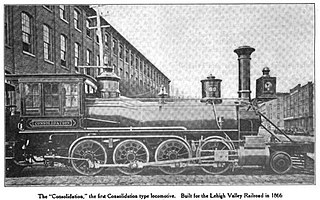
Under the Whyte notation for the classification of steam locomotives, 2-8-0 represents the wheel arrangement of two leading wheels on one axle, usually in a leading truck, eight powered and coupled driving wheels on four axles, and no trailing wheels. In the United States and elsewhere, this wheel arrangement is commonly known as a Consolidation, after the Lehigh and Mahanoy Railroad’s Consolidation, the name of the first 2-8-0.

The Trans-Iranian Railway was a major railway building project started in Pahlavi Iran in 1927 and completed in 1938, under the direction of the then-Iranian monarch Reza Shah. It was entirely built with indigenous capital, and links the capital Tehran with Bandar Shahpur on the Persian Gulf in the south and Bandar Shah on the Caspian Sea in the north, via Ahvaz and Ghom. In 1961, under Reza Shah's son Mohammad Reza Pahlavi, it was extended from Bandar Shah to a new terminus in Gorgan. During the land reforms of Mohammad Reza Pahlavi in 1963, as part of the "White Revolution", the Trans-Iranian railway was extended to link Tehran to Mashhad, Tabriz and Isfahan.

The London, Midland and Scottish Railway (LMS) Stanier Class 8F is a class of steam locomotives designed for hauling heavy freight. 852 were built between 1935 and 1946, as a freight version of William Stanier's successful Black Five, and the class saw extensive service overseas during and after the Second World War.

The War Department (WD) "Austerity" 2-8-0 is a type of heavy freight steam locomotive that was introduced in 1943 for war service. A total of 935 were built, making this one of the most-produced classes of British steam locomotive. They were nicknamed Ozzies by the railwaymen.

The United States Army Transportation Corps (USATC) S100 Class is a 0-6-0 steam locomotive that was designed for switching (shunting) duties in Europe and North Africa during World War II. After the war, they were used on railways in Austria, China, Egypt, France, Great Britain, Greece, Iran, Iraq, Israel, Italy, the Netherlands, Palestine, the United States, and Yugoslavia.
The United States Army Transportation Corps S160 Class is a class of 2-8-0 Consolidation steam locomotive, designed for heavy freight work in Europe during World War II. A total of 2,120 were built and they worked on railroads across much of the world, including Africa, Asia, all of Europe and South America.

The United States Army Transportation Corps (USATC) S200 Class is a class of 2-8-2 steam locomotive. They were introduced in 1941 and lent-leased to the United Kingdom for use in the Middle East during World War II.
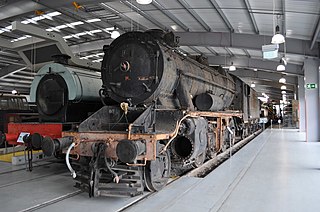
The TCDD 45151 Class is a class of 2-8-0 steam locomotives which were acquired from the British War Department to the LMS Stanier Class 8F design. They had a maximum speed of 43 miles per hour (70 km/h), much like their British counterparts.

The TCDD 56501 Class is a class of 2-10-0 steam locomotives provided by Germany during the Second World War. They were numbered 56501-56553.

TCDD 45171 Class is a class of 2-8-0 steam locomotives. The class was formed when 50 USATC S160 Class were bought in 1947.

The Turkish State Railways (TCDD) 56301 Class is a class of 2-10-0 steam locomotives known as "Skyliners". They were built by Vulcan Iron Works of Wilkes-Barre, Pennsylvania. The 88 locomotives in this class were numbered 56301-88. The first arrived in 1947.
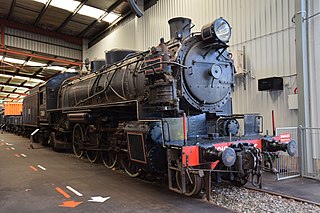
The 59 class is a class of steam locomotive built by Baldwin-Lima-Hamilton Corporation for the New South Wales Government Railways of Australia.
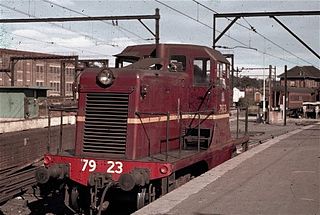
The 79 class is a diesel-electric locomotive built by General Electric, Erie, United States for the Department of Railways New South Wales in 1943.

SEKClass Θγ was a class of 2-8-0 steam locomotives ex-United States Army Transportation Corps S160 type. 27 locomotives were acquired in 1947; Θγ521–537 were coal burners, while Θγ551–560 were oil burners. In 1959, Italian Railways sold another 25, formerly Class 736, Nos 736.011/23/40/55/73/90/101/2/126/7/131/5/51/8/60/4/6/78/88/90/9/203/7/9/17 to SEK. These were renumbered Θγ571-95 in the same order.
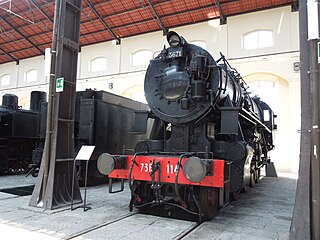
Ferrovie dello Stato Class 736 was a class of 2-8-0 steam locomotives ex-United States Army Transportation Corps (USATC) 2-8-0 steam locomotives of the S160 Class. There were 243 locomotives in this class, numbered 736.001-243. They were taken to Italy by invading US forces.

The TCDD Open Air Steam Locomotive Museum is a railroad museum in Ankara, Turkey, which focuses on the history of steam locomotives that operated on the Turkish State Railways. The museum was originally located in a park adjacent to Ankara Central Station, and when the property was needed for the station's enlargement project in 2014, the museum was moved to the current location near Wonderland Eurasia. The museum is owned and operated by the Turkish State Railways (TCDD), who also manages the Ankara Railway History Museum, as well as Atatürk's Car and Railway Art Museum.

The Çamlık Railway Museum, a.k.a. Çamlık Steam Locomotive Museum, is an outdoor railway museum at Çamlık village of Selçuk district in Izmir Province, Turkey. It is the largest railway museum in Turkey and contains one of the largest steam locomotive collections in Europe.

The Queensland Railways AC16 class locomotive was a class of 2-8-2 steam locomotives operated by the Queensland Railways.

The Manila Railroad 800 class USA were 45 United States Army Transportation Corps class S118 steam locomotives used by the Manila Railroad Company and the Philippine National Railways. Originally built by Vulcan Iron Works and the American Locomotive Works for the United States Army during the Second Philippines Campaign, they were later used to pull freight trains and temporary passenger trains. After the dieselization of the Manila Railroad network in the mid-1950s, they were relegated to work trains until the last unit was scrapped after appearing in a 1989 World War II movie.


















